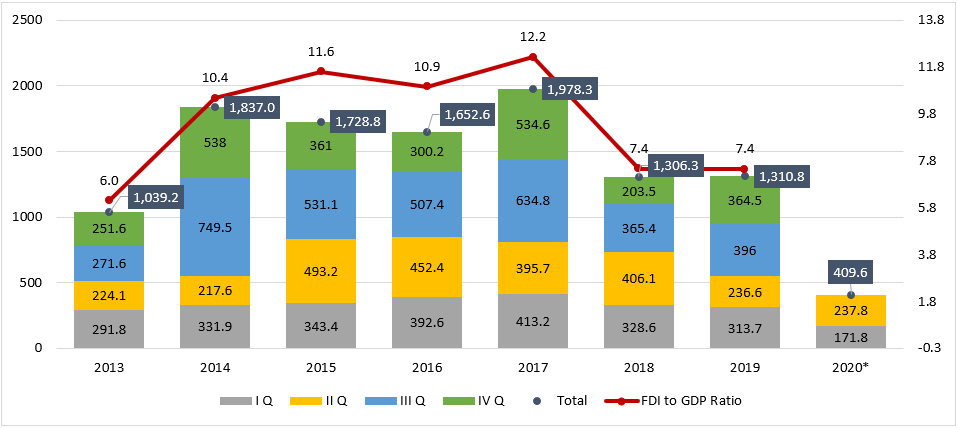Resume:
It is unclear to which countries Badri Japaridze is referring when he mentions the word region in his statement. We can assume that the reference encompasses the country’s neighbour countries at the very least. Therefore, an analysis of Georgia’s neighbour countries would be sufficient to verify the statement in this case. In the nearest past, only Armenia outperformed Georgia in terms of economic growth. As of 2019, Armenia’s economic growth rate was 7.6%, followed by Georgia’s 5.1%, Azerbaijan’s 2.2%, Russia’s 1.3% and Turkey’s 0.9%. In the post-pandemic years, Georgia’s estimated economic growth rate would be one of the highest both in the region and across Europe. Therefore, highlighting Georgia’s low economic growth rate whilst making a comparison to the region is a wrong approach. Although, in spite of this it is a fact that a 3% to 5% economic growth rate is a low figure for a developing country like Georgia.
In 2019, foreign direct investments (FDI) amounted to USD 1.3 billion which is only USD 4 million more as compared to 2018’s figure. However, together with the absolute figure, it is also important to analyse the FDI to GDP ratio since a relative figure shows the portion of investments within the economy. In 2014-2017, the FDI to GDP ratio was 11.3% on average whilst it dropped to 7.4% in 2018-2019. The FDI to GDP ratio in 2019 was 7.4% – the lowest since 2013.
Analysis
The leader of the political union Lelo, Badri Japaridze, stated: “Thanks to the government, Georgia was the least growing country before the COVID pandemic, foreign direct investments were reduced to a minimum.”
The gross domestic product (GDP) is an internationally accepted indicator for the measurement of a country’s well-being. The GDP reflects the final market value of the goods and services produced within a country for year. As a result of the novel coronavirus pandemic-induced crisis, the absolute majority of the countries across the world experience economic decline. According to the forecast of the International Monetary Fund, Georgia’s economy will contract by 5% in 2020, although Mr Japaridze names the pre-pandemic period.
It is unclear to which countries Badri Japaridze is referring when he mentions the word region in his statement since there are different categorisations of the region where Georgia belongs. However, in order to verify this part of the statement it would be sufficient to analyse the economic growth rates of Georgia’s neighbour countries which are definitely part of Georgia’s region. In the nearest past, only Armenia outperformed Georgia in terms of the economic growth rate. As of 2019, Armenia’s economic growth rate was 7.6% followed by Georgia’s 5.1%, Azerbaijan’s 2.2%, Russia’s 1.3% and Turkey’s 0.9%.
Of note is that in the post-pandemic years, Georgia’s economic growth rate will be one of the highest both in the region and as compared to all European countries. Therefore, highlighting Georgia’s low economic growth rate whilst making a comparison to the region is a wrong approach. In spite of this, however, it is a fact that a 3% to 5% economic growth rate is very a low figure for a developing country like Georgia.
Graph 1: Real GDP Growth Figures in Georgia and Neighbour Countries, 2013-2019

Source: World Bank
Foreign direct investment (FDI) implies a resident of one country owning a share in a foreign-based enterprise and carrying out different types of economic operations related to that enterprise. An investor is considered to be a direct one if he has at least a 10% ownership stake in a foreign-based enterprise’s shares or the equivalent of such participation.
In accordance with the preliminary data of the National Statistics Office of Georgia, USD 237.8 million in foreign direct investments were made in Georgia in the second quarter of 2020 which is 0.5% (USD 1.2 million) more as compared to the same quarter of 2019. In regard to the first half of this year, a total of USD 409.6 million was invested in the first six months of 2020 which is 25.6% less as compared to the same period of the previous year. The current volume of half-year investments stands at the lowest in first half-year figures of the last decade.
To some extent, the pandemic-induced crisis is a reason behind this decrease although a sharp trend of FDI decrease was clear-cut prior to the pandemic and poses a significant problem. In this regard, Mr Japaridze’s statement is indeed true.
Graph 2: Foreign Direct Investments in 2013-2020 (Two Quarters).

Source: National Statistics Office of Georgia
Graph 1 illustrates the FDI quarterly statistics. In 2019, the FDI amounted to USD 1.3 billion which is only USD 4 million more as compared to 2018’s figure. However, it is also important to analyse the FDI to the GDP ratio together with the absolute figure since a relative figure shows the portion of investments within the economy. In 2014-2017, the FDI to the GDP ratio was 11.3% on average whilst it dropped to 7.4% in 2018-2019. The actual FDI to the GDP ratio in 2019 was 7.4% – the lowest since 2013.







